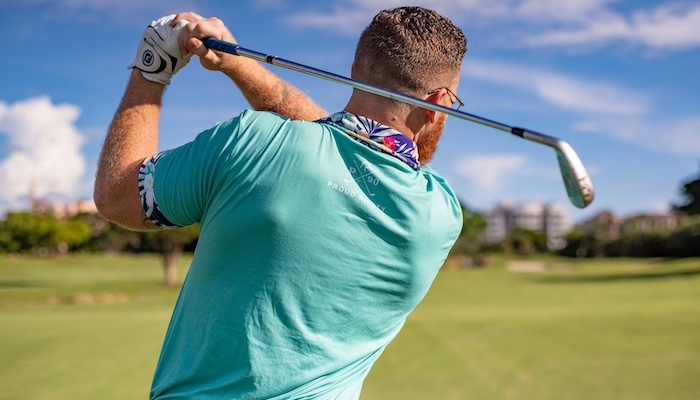
For the millions of people who have long-standing low back pain, golf can still be an enjoyable sport. Using the right equipment, alongside a routine of stretching and low-impact exercise, will go a long way in helping maintain one’s ability to play golf.
Use a Golf Cart
Many golfers continue to play as they age, and most expect to be able to continue to play during their retirement years. Unfortunately, some elderly individuals will develop conditions such as spinal stenosis or degenerative spondylolisthesis, which makes it difficult for them to walk any significant distance on the golf course.
Using a golf cart is a reasonable alternative to walking on the golf course. To maintain aerobic conditioning with spinal stenosis or degenerative spondylolisthesis, biking or water therapy may be tolerated better than walking.
Wear Supportive Footwear
Ill-fitting shoes may cause or contribute to back pain. High-quality shoes for golf foster spinal alignment and upright posture, allowing golfers to be comfortable throughout the game and the long walks on the golf course.
The ideal golfing shoes, with or without spikes, will:
- Absorb impact from the forces generated by the golf swing
- Stabilize the feet with a snug fit
- Distribute weight around the sole
- Maintain traction
- Be lightweight and flexible
- Have a supportive and durable raised arch, especially for individuals with flat feet
- Have customized shoe inserts, or orthotics
Foot orthotics effectively protect the wearer from injury, but shock-absorbing insoles have not been proven effective. Foot exercises can be added to the stretching and exercise routine to strengthen the arch and the surrounding muscles.
Modify the Golf Swing
An ideal golf swing is smooth, fluid, and rhythmic. Understanding the biomechanics of the swing helps to prevent back injuries such as muscle strains. Modification of the golf swing may be necessary for the injured or elderly athlete.
Modifications apply to all 4 components of the golf swing:
The Backswing, or Takeaway
Once the club starts to move, the erector spinal and abdominal oblique muscles are activated on the left side, assuming the golfer is right-handed. At the start of the swing:
- Stand closer to the ball
- Keep the backswing short, to help reduce the load on the back
- Rotate the head slightly, with the nose aligning over the right foot, rather than keeping the head still
Switching to a short backswing will require training or practice, to prevent strain in the shoulder muscles. An added benefit of this modification is improved shot accuracy.
The Forward Swing, or Downswing
As the club starts to come back down, the gluteus maximus and the hamstrings on the dominant side are most engaged. During the downswing:
- Rotate side-to-side, to avoid standing upright as the club moves
- Avoid shifting weight into the forward leg too soon
- Keep the pelvis tucked in, the glutes pushed back, and the chest down
- Keep the back leg bent
While these aspects of the downswing maximize the rotation, it is important not to rotate the body beyond its range of motion.
The Acceleration with Ball Strike, or Ball Contact
As the downswing comes to an end, the hamstrings and the gluteus maximus are engaged on the lead leg, while the abdominal oblique muscle is most engaged on the dominant side. After impact on the ball:
- Avoid rotating the upper body too soon
- Shift the weight onto the forward leg, by keeping the forward leg locked in position as the back leg turns and touches the forward leg
- Tilt the back foot onto the toes and, if possible, lift the toes off the ground into the follow-through
This swing modification will take practice and needs to be started gradually, at a slower rate of rotation, before becoming accustomed to the change.
The Follow-Through
After the impact on the ball, the hamstrings remain the most active muscles on the lead side, and the gluteus medius and abdominal oblique are most active on the back side. Once the dominant arm becomes parallel to the ground, it helps to:
- Turn the head and body forward to look towards the ball
- Keep the follow-through short
- Finish with the club on a slight angle over the shoulder, rather than a deep tilt
This modification will decrease the bend in the spine as the swing comes to an end, to relieve the load on the lower back.
Golfing After Spine Surgery
Research suggests that spine surgery does not mean the end of playing golf. Within a year after undergoing lumbar fusion surgery:
- 77% of golfers could play golf as frequently or more frequently than before surgery
- 29% of golfers still felt limited in their ability to play golf, compared to 79% of golfers before surgery
While returning to golf is well within reach, sufficient recovery time needs to be allotted. While recovery times vary based on the patient’s condition, the surgeon’s surgical technique, and the outcome of the surgery, the general guidelines for recommended recovery times are:
- 1 to 2 months after lumbar laminectomy or lumbar microdiscectomy
- 2 to 3 months after anterior cervical fusion
- 6 months after lumbar fusion
Among other factors, it is important to be pain-free with fully regained strength and range of motion before returning to the golf course.
Precision Pain Care and Rehabilitation has two convenient locations in Richmond Hill – Queens, and New Hyde Park – Long Island. Call the Queens office at (718) 215-1888 or (516) 419-4480 for the Long Island office to arrange an appointment with our Interventional Pain Management Specialists, Dr. Jeffrey Chacko or Dr. Sonny Ahluwalia.















